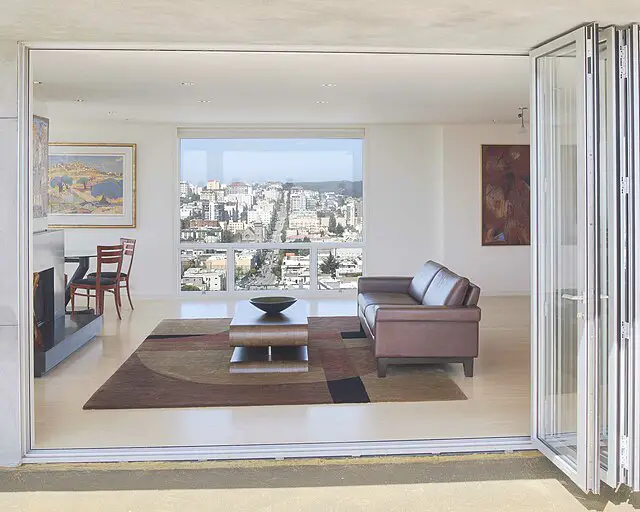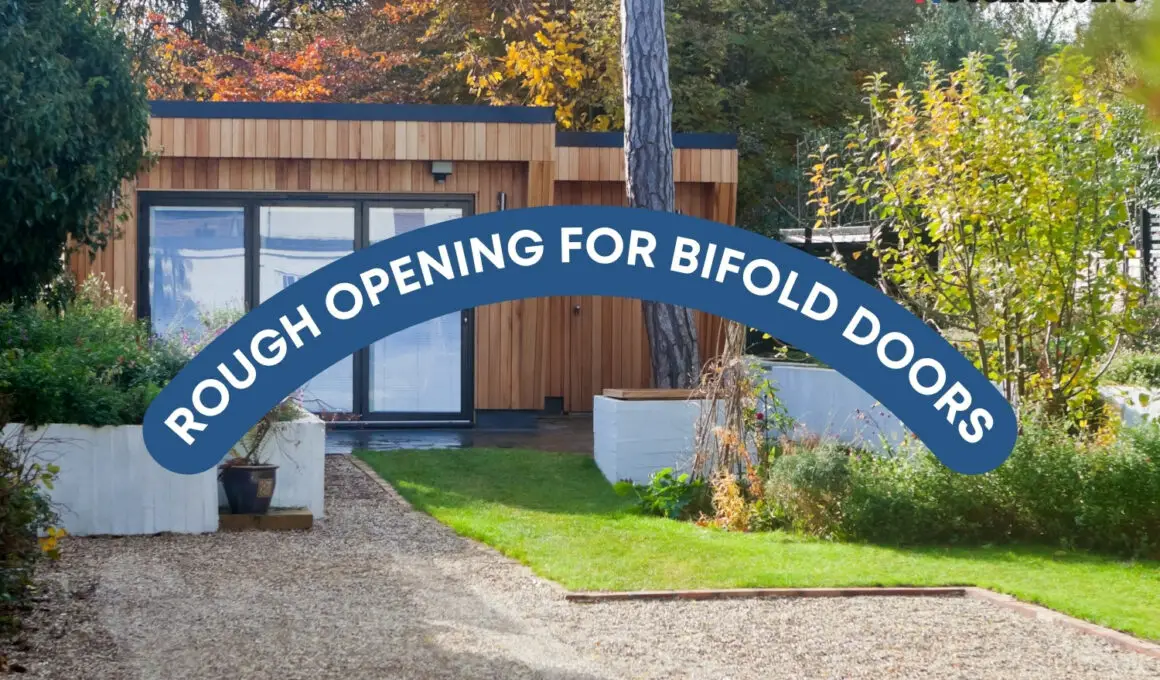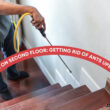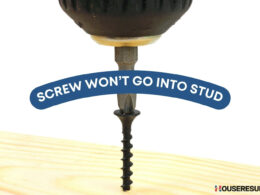Table of Contents Show
Are you in the market for new doors and considering bifold doors for your home? You’ve made an excellent choice! As an experienced homeowner and self-proclaimed DIY expert with over 13 years in the field, I can confidently tell you that the addition of bifold doors can transform any space.
Not only do they save space and enhance accessibility, but their unique opening mechanism adds a stylish touch to your interior design.
In this blog post, we’re diving deep into the world of bifold doors – specifically, the crucial details about their rough opening measurements and some handy installation tips. In my years of experience, I’ve seen many homeowners stumble over these aspects, and it’s my aim to ensure you don’t face the same hurdles.
Understanding the ins and outs of bifold doors is key to their successful installation and longevity. Let’s take this journey together, where I’ll be sharing practical knowledge gleaned from my own hands-on experience installing and maintaining these doors in a variety of homes.
Whether you’re a DIY enthusiast looking to take on a new project, or simply exploring your options for a home makeover, this guide will be valuable for you. Remember, even the most beautiful bifold door won’t be of much use if it isn’t properly fitted.
Understanding Bifold Doors
Bifold doors, as the name suggests, are doors that fold in half. This unique design is what makes them a perfect fit for homes where space is a premium or where a standard door’s swing could obstruct the room’s flow.
Different Types of Bifold Doors
The first thing to note is that not all bifold doors are created equal. They come in a variety of styles, materials, and finishes to suit various aesthetics and functional needs. Some of the most common types include wood bifold doors, which bring a classic warmth to any space, and aluminum or glass bifold doors, which can lend a modern, sleek look.
Remember, choosing the right type of bifold door is more than just picking the most attractive option; you also need to consider factors like durability, maintenance requirements, and insulation properties.
Pros and Cons of Using Bifold Doors
As a professional organizer with over a decade of experience, I can testify to the multiple benefits of bifold doors. Firstly, they are great space-savers as they fold back onto themselves, freeing up space in your room layout. This feature is particularly handy in smaller homes or rooms with limited floor area.
Secondly, bifold doors can be fully opened, unlike sliding doors, providing unrestricted access to wardrobes, pantries, or between rooms.
However, like everything, they come with their own set of considerations. They have more moving parts than standard doors, which can lead to increased maintenance. Also, the installation process is a bit more complex, requiring accurate measurements for the rough opening.
Key Measurements for Bifold Doors
Accurate measurements are the cornerstone of a successful bifold door installation. Understanding the right measurements for your door will help ensure a smooth opening and closing mechanism, and prevent potential mishaps down the line.
| Bifold Door Width (in inches) | Individual Panel Width (in inches) | Rough Opening Width (in inches) |
|---|---|---|
| 24 | 12 | 26 |
| 30 | 15 | 32 |
| 32 | 16 | 34 |
| 36 | 18 | 38 |
| 48 | 24 | 50 |
| 60 | 30 | 62 |
| 72 | 36 | 74 |
Standard Sizes of Bifold Doors
Bifold doors come in a range of standard sizes. The most common widths are 24, 30, 32, and 36 inches. The height is typically 80 inches, but 78 inches and 96 inches are also common for certain spaces.
It’s essential to remember that these measurements are for each panel of the door. So, for instance, a 48-inch bifold door consists of two panels of 24 inches each. Always double-check whether the measurements you see in stores or online refer to the total door width or individual panel width.
Calculating The Rough Opening Size
When it comes to installing a bifold door, the rough opening’s size is a critical factor. The rough opening is essentially the opening created in the wall where the door will be installed.
As a rule of thumb, the rough opening’s width should be 2 inches more than the overall width of the bifold doors, and the height should be 2 inches more than the doors’ height. This allows for wiggle room and adjustments during installation.
Importance of Accurate Measurements
In my 13 years of experience as a professional organizer and homeowner, I’ve often emphasized the importance of accurate measurements. Incorrect measurements can lead to improper fits, which could affect the functionality of your bifold doors and eventually lead to more maintenance issues.
| Bifold Door Height (in inches) | Rough Opening Height (in inches) |
|---|---|
| 78 | 80 |
| 80 | 82 |
| 96 | 98 |
Always measure twice and cut once! And remember, it’s not just about measuring the door size, but also the rough opening where the door will be installed. If you’re unsure, it’s always best to consult with a professional or refer to a detailed guide like this one.
Installation Tips for Bifold Doors

Now that we’ve got our measurements nailed down, let’s discuss the actual installation of bifold doors. As an experienced homeowner and professional organizer, I can tell you that installing these doors is a rewarding DIY project. However, it does require some care and precision.
Pre-Installation Preparation:
Before you begin the actual installation, there are a few preparatory steps you must take. Check the rough opening measurements again for accuracy. Remember the saying, “Measure twice, cut once”? It’s crucial here.
Ensure the floor under the door is level. Any unevenness can affect the door’s operation. Then, prepare your tools. You will typically need a drill, screwdriver, level, tape measure, and pencil for marking.
Step-by-Step Guide to Installing Bifold Doors
Follow these steps to install your bifold doors successfully:
- Install the track: Fix the track at the top of the rough opening using the screws provided.
- Attach hardware to doors: Follow the manufacturer’s instructions to attach the hardware like pivot brackets and rollers.
- Hang the doors: Place the top pivot into the bracket in the track. Then, slide the bottom pivot into the bottom bracket and adjust as necessary.
- Install door aligners: This help keep the doors aligned and in place. They should be attached to the back of each door set.
- Make necessary adjustments: Use the adjustment screws on the pivots to ensure the doors open and close smoothly.
Common Mistakes to Avoid During Installation
In my many years of experience, I’ve seen a few common mistakes people often make when installing bifold doors:
Not checking the level of the floor or the alignment of the door after installation. This can lead to the door dragging or not closing properly.
Overlooking the importance of precise measurements. An incorrectly measured rough opening can result in poor fit and functional issues.
Ignoring the manufacturer’s instructions. Each door can have specific hardware and installation requirements. It’s essential to follow the provided instructions.
Maintenance and Troubleshooting Tips
Even the best-installed bifold doors can encounter issues over time due to regular wear and tear. However, with some routine maintenance and a little knowledge, you can keep your doors functioning smoothly for years to come.
Here are some tips to maintain your bifold doors:
- Regularly clean the tracks: Dust and debris can accumulate in the tracks and hinder the door’s movement. Use a vacuum or damp cloth to clean the tracks regularly.
- Lubricate the tracks and pivots: Apply a silicone-based lubricant to the tracks and pivot points occasionally to ensure smooth operation.
- Check and tighten hardware: Over time, screws and bolts can loosen. Regularly inspect your door hardware and tighten any loose components.
Troubleshooting Common Bifold Door Issues:
Despite our best efforts, issues can arise. Here are some common problems and their solutions:
- The door is hard to move or is stuck: This could be due to debris in the track or a need for lubrication. Clean and lubricate the track and check for any obstructions.
- The door doesn’t close completely: This could indicate an alignment issue. Check the alignment and adjust the pivot points as necessary.
- Door swings open: This could be due to an imbalance. Ensure the doors are properly adjusted and balanced according to the manufacturer’s instructions.
These are just some common issues you might face. However, remember that each situation can be unique, and when in doubt, it’s always best to consult with a professional.
Wrapping it up
Bifold doors, with their space-saving design and unique operation, can make a stylish and functional addition to any home. However, proper measurements, careful installation, and routine maintenance are vital for their optimum performance and longevity.
As an experienced homeowner with one of these at home, I can confidently say that with the correct guidance and a little patience, installing and maintaining bifold doors is a task well within your reach.
Through this guide, I’ve shared my insights and knowledge, hoping it will help you on your journey to successfully installing your bifold doors. Remember, the key is in the details – measure accurately, install carefully, and maintain regularly.













